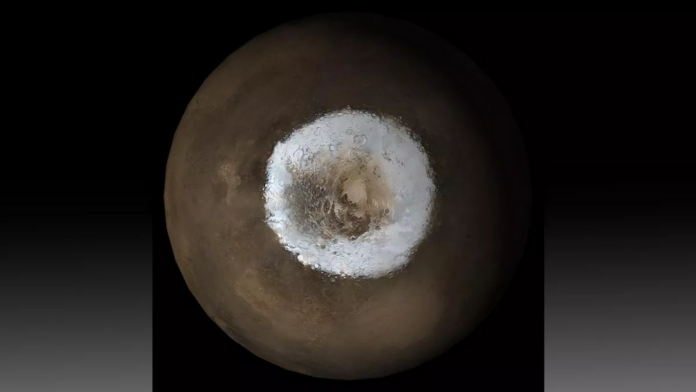Mars is spinning faster, and scientists aren’t sure why
Mars and its polar cap.
Data from NASA’s InSight mission shows that Mars’s rotation is speeding up and its days are growing slightly shorter. Scientists have a few ideas why.
Like an ice skater tucking their arms for an elegant spin, the planet Mars appears to be rotating slightly faster with each passing year.
In a paper published June 14 in the journal Nature, astronomers used data from NASA’s InSight mission to show that the Red Planet’s spin is accelerating at a rate of 4 milliarcseconds — one one-thousandth of an arcsecond, a unit of angularity — per year. As a result, the length of a Martian day is getting shorter by fractions of a millisecond annually.
Such changes in rotation can be difficult to detect. Luckily, InSight was able to collect over four years of data before it ran out of power in December 2022. The new study examined measurements taken from the mission’s first 900 days on Mars — enough time to pick up on even subtle changes in planetary spin.
By bouncing radio waves into space and assessing how long they took to get back to the surface of the planet, InSight painted a detailed portrait of the planet’s spin.
Scientists aren’t 100% sure what’s causing the acceleration, but they have a few ideas. One is that ice accumulation at the planet’s poles is causing a slight change in how its mass was distributed. Or, the researchers hypothesize, it could be due to a phenomenon called post-glacial rebound, where landmasses rise up after millennia buried under the ice. In either case, the gradual shift might have been enough to subtly change Mars’s rotation over huge spans of time.
In addition to tracking the planet’s spin, InSight’s data provided an unprecedented look into Mars’s core. Upon analyzing it, researchers discovered that the Martian core has a radius of about 1,150 miles (1,850 kilometers) — smaller than Earth’s 2,165 mile (3,485 kilometer) core, but larger in proportion to the planet. The study also revealed that this core is not uniform. Instead, it has regions of higher or lower density, causing its molten material to “slosh” as Mars spins. This, the study suggests, could be another possible reason for the Red Planet’s accelerated spin.
“It’s a historic experiment,” Sebastien Le Maistre, a planetary scientist at the Royal Observatory of Belgium and lead author of the study, said in a statement. “We have spent a lot of time and energy preparing for the experiment and anticipating these discoveries. But despite this, we were still surprised along the way.”

